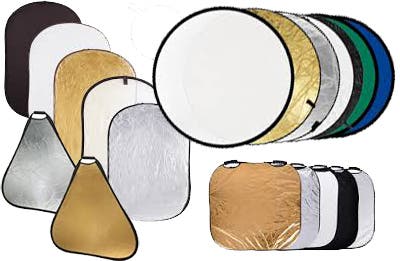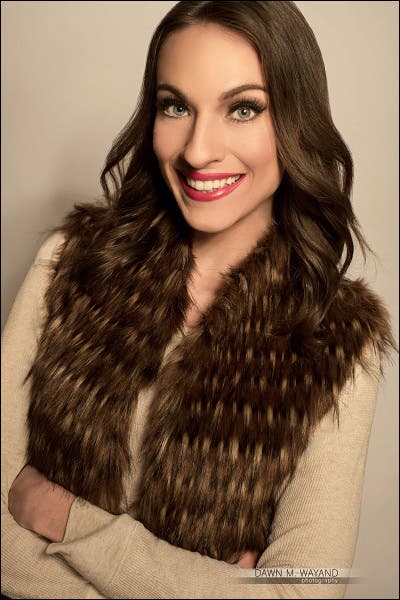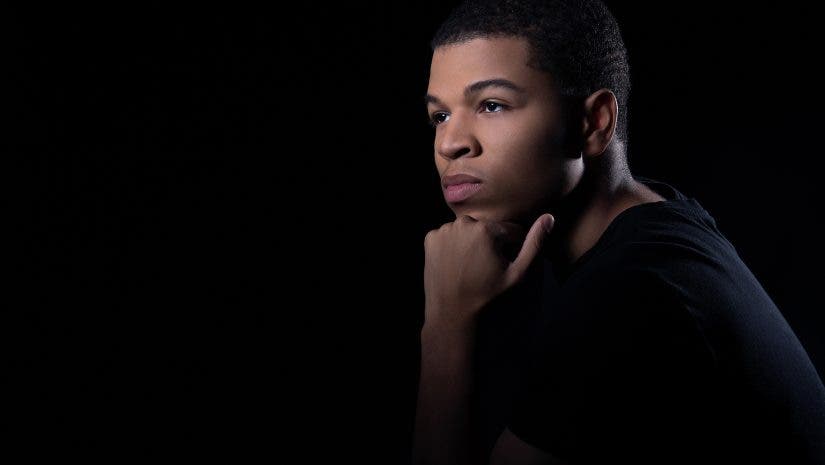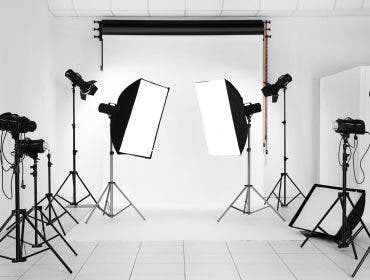So you’ve just picked up a monolight or strobe for your studio setup, or maybe you already have that and you are looking for tips on diffusing and shaping the light that comes from it. Acquiring a modifier for that light is pretty much a necessity as without a way to diffuse a light source, the light ends up being harsh, producing high contrast. You also end up losing any control over the light as the light spills everywhere.

An 11” long throw metal reflector was used as a front light and a 7” metal reflector was used as a rim light.
Model: Deeksha Chawla
You have several options for light modifiers (depending on the type of monolight or strobe that you buy since some light models are limited on modifier options…) Which modifiers you choose depend on the result you are aiming for in your images. Below are nine light modifier options that can help you diffuse and shape light in your studio work.
COLLAPSIBLE REFLECTORS
While not everyone has an easy time folding them back up, most of us know what a collapsible reflector is and many folks have actually successfully used one. They should really be your first light modifier, even before you buy your first monolight or strobe because they are useful outside in the field too. They work for not only lighting people outdoors, but subjects like flowers too.

Collapsible Reflectors come in a variety of shapes, sizes and colors.
Reflectors do exactly what their name might imply: they reflect light. They are used to bounce light from a light source back onto a subject. Photographing a person outdoors in the sun? We generally put the sun behind our subject to avoid him or her squinting, but then our subject becomes too dark because the light behind him or her is so bright. A reflector can be used to bounce light from the sun behind the subject back onto him/her so that the subject is also lit. This works the same way in a studio.

The image on the left was taken without a collapsible reflector and the image on the right was taken using a collapsible reflector.
Model: Katie Buell
As you can see through the images above, in the image on the right, the reflector helped to fill in the under-eye and under-chin shadows, shine a little more light onto her hair, which in turn, created a little more texture as well as put an extra catchlight in her eyes.
Collapsible reflectors come in a variety of shapes, sizes and colors. I try to stick with at least a 5-in-1 reflector, which means that there are five color options in one reflector kit. Below you can see the effect of the different colors in my 32” 5-in-1 reflector: (1) Black – takes away light, (2) Translucent Diffuser – diffuses the light, (3) Silver – creates soft specular highlights, (4) White – creates highlights and (5) Gold – warms the subject.

The effects of a 5-in-1 reflector.
You can learn more about collapsible reflectors colors and what the different shapes and sizes do in my article: Building the Home Studio Part 04 – Essential Studio Tools, Props and Odds & Ends.
METAL REFLECTORS
Metal reflectors are those circular metal bowls that attach around the bulb or flashtube of your monolight or strobe and light reflects from the bowl directly onto your subject.

Flashpoint 8-1/4″ Reflector to Fit Elinchrom>
Image courtesy of Adorama
Some monolights and strobes come with a metal reflector as a starter modifier. They are generally great for background and rim light use.

The metal reflector helped add depth to my image by lighting the background
while I shot through Saran-wrapped Plexiglas for a dreamy effect.
Model/Dancer: Shoko Fujita
While they tend to cast a very harsh light, I have often been able to pull them off as a front light, such as in the first image of this article, a floor light, such as in the image immediately above, and especially for photographing males (where a more harsh light may be desired) by positioning them further away from a subject and setting the light at a lower power, such as in the image below.

Positioning a metal reflector far from a subject and setting the light at a lower power worked for this shot.
Actor: Patrick Walsh
UMBRELLAS
Umbrellas are probably one of the first studio modifiers that are ever purchased by photographers as they are cheap, portable and come in a variety of sizes and colors.
Shoot Through Umbrellas

Shoot-Through Umbrella
Image courtesy of Adorama
White shoot-through, or translucent, umbrellas are one of the more common umbrellas used in photography because the shaft of the umbrella is pointed away from a subject when lighting, which means a light source can be moved in as close as desired without poking out their eye! The downside to a shoot through umbrellas is that the light is hard to control because the umbrella is translucent and the light spills everywhere.

Shoot through umbrellas make great beauty lighting modifiers, but the light is hard to control.
Model: Katie Buell
In the image above, I used the inexpensive JTL 40-inch White Umbrella w/ Removable Black Cover with the black cover removed.
Black/White Umbrellas

Black/White Umbrella
Image courtesy of Adorama
Black/white umbrellas are a great choice for when you need to fill in shadows without it affecting the color, quality or quantity of light. In the image below, I used the JTL 40-inch White Umbrella w/ Removable Black Cover, but with the cover on.

Black & white umbrellas are great for filling in shadows without affecting the light.
Model: Katie Buell
Black/Silver Umbrellas

Black/Silver Umbrella
Image courtesy of Adorama
A reflective umbrella, a silver umbrella (with a black covering) can be used when you want to bounce in specular highlights without affecting the color of the light. The light will be subtly harsher than a shoot through, depending on your umbrella’s distance from your lightsource and from your subject as well as the size of the umbrella.

Silver umbrellas bounce in specular highlights without affecting the color of the light.
Model: Katie Buell
In the image above, I used something similar to the Phottix 40” Two-Layer Silver Reflective Umbrella available at Adorama for $17.95 each.
Black/Gold Umbrellas

Black/Gold Umbrella
Image courtesy of Adorama
A gold umbrella with black backing can be used to warm the color of an image and your subject. This umbrella color works well when photographing someone in a bathing suit or photographing someone with a very fair skin tone, where a healthy warm glow might be desired.

Just an example of the warming effect of a gold umbrella…
Model: Katie Buell
Above, I used something similar to the Phottix 40” Two-Layer Gold Reflective Umbrella available at Adorama for around $21.95 each.
Parabolic Umbrellas

The use of a 7-foot parabolic umbrella.
The larger your umbrella is, the more your light will be spread out. Larger umbrellas, like parabolic umbrellas, are great for full body shots, group shots and portraits, where smaller umbrellas project a more narrow focus, therefore, better for some portraits and headshots. For the image below, I used a Westcott 7-foot Silver Parabolic Umbrella.

Parabolic umbrellas can make for beautiful full body shots, group shots and portraits.
Model: Katie Buell
SOFTBOXES
Whether using continuous lighting, speedlights or strobes, softboxes prove to be one of the best light shaping tools for any professional photographer’s to have in their toolbox.
Round

Image courtesy of Adorama
Round softboxes, called octaboxes or octabanks, make for wonderful key lights. Their round shape is similar to the sun and the catchlights produced by round softboxes can be much more pleasing to some as they cast a more natural round catchlight into a subject’s eyes to match the roundness of the pupils.

Light is wrapped around my model here and the octabox creates round catchlights in the eyes.
Model: James Campbell
An octabox also tends to wrap light around its subject. I find a larger octabox placed close to my subjects face serves close to what a beauty dish would do for me when placed straight in front of my subject. When placed anywhere else, shadows can vary from subtle to harsh depending on its proximity to the subject. I’m personally a huge fan of the 43” Westcott Apollo Orb because it’s easy to set up and break down – much like an umbrella!
Squares and Rectangles

Image courtesy of Adorama
Squares and rectangles work well as main light sources as well as a fill lights. Depending on their size, they tend to throw out a more defined light complete with a nice and soft transitioning of shadows.

Square softboxes create soft shadow transitioning and leave square catchlights in the eyes.
Model: Xavier Lujan
Contrary to some preferences, I find squares to make interesting and dynamic catchlights in the eyes when used in conjunction with a circular or triangular reflector as shown above. In this image, I used a Glow 24” x 24” Square Softbox which has a large variety of speed ring adapters available, sold separately.
Strips

Interfit Photographic Strip Light Softbox for Strobes, 28×75″
Image courtesy of Adorama
Strip softboxes are great for lighting the full body when placed parallel with a subject. They also work well as hair lights. I used a softbox similar to the Westcott 12”x36” Strip Bank for the image below.

Strip softboxes are good for full length images and create long narrow catchlights in the eyes.
Model: Katie Buell
Depending on the distance from the subject, strip softboxes can create a very subtle or a very harsh transitioning in shadows.
BEAUTY DISHES
Beauty dishes are beautiful! If you are into portrait or beauty photography, a beauty dish is a “must”. A beauty dish is a circular reflector or bowl with an opening in the center that attaches to a monolight or strobe. The bulb or flash is hidden by a raised plate in the center that forces light to disburse into bowl and onto a subject rather than the light source directly hitting the subject.

A silver and a white beauty dish (left to right).
Images courtesy of Adorama
Beauty dishes come as white or silver coated on the inside. White coated dishes make for a softer light whereas silver coated dishes make for slightly more contrast.

Image taken using a 16-inch white beauty dish with a diffuser as a main light.
Model: Maria Iodice
Beauty dishes have two different companion modifiers that can be used along with them: a diffuser, sometimes called a “sock”, and a grid. The image above was taken using a diffuser while the image below was taken using a grid.

Image taken using a 16-inch white beauty dish with a grid.
Model: Xavier Lujan
I’ve always had a regret of buying such a small beauty dish – at 16 inches. If you can swing it, get something at least 22 inches in diameter or more. Which beauty dish you should get will depend on the monolight or strobe that you have. Brands like Glow make a variety of mount options to work for more than one single brand.
GRIDS
If you need the direction of light from your light source to be more concise, a grid is your best bet. Grids are useful when you want to light something specific with little to no spill, such as when you want to light your subject but you want to keep the background dark.

Grid on a beauty dish.
Image by Yann Bizeul
Grids are typically made to work with beauty dishes and softboxes, but I’ve also found them as companion modifiers for barndoors and snoots too. They come in different sizes, the hole width determining the width of the light beam emitted.

The use of a grid on a beauty dish.
Model: Tara Virada
Grids come in a variety of types, brands, sizes and hole widths and which you get will depend on the type and brand of main modifier you use it with.
BARNDOORS
Barndoors are one of the most versatile and inexpensive lighting modifiers one could own. This modifier is basically four doors that attach to a base which can be attached to a monolight or strobe.

Flashpoint Universal Barn Door Kit with Grid and Gels
Image courtesy of Adorama
What’s versatile about this modifier is that these 4 doors can be opened as little or as much as desired allowing for numerous lighting results. Many barn doors are sold as kits that also include companion modifiers of four gels and a grid, such as Flashpoint’s Universal Barn Door Kit featured above.

A quick example of the use of barn doors bare on a subject.
Model: Matt Chamberlain
Above I used the barn doors bare with each door opened halfway, which produced a very harsh light on my subject whereas below, I popped a grid onto the barndoors and while the light is still a bit harsh, notice that the background goes dark. As noted previously, grids help direct light in a specific direction leaving little spill, if any. The light doesn’t wrap around my subject and hit the background in this case. The light only hits my subject.

A quick example of the use of barn doors with a grid.
Model: Matt Chamberlain
SNOOTS

Flashpoint Snoot Kit for Bowens Mount Strobes>
Image courtesy of Adorama
Snoots are serious business. They allow you to focus in specifically on one small thing on a subject, such as just the face, just the hands or for baby photography, just the feet. They are also a great tool for lighting particular things for an interior shoot or even products because the light is so concentrated and direct.

A snoot used bare in the front with a beauty dish and grid used as a rim light behind my subject.
Model: Celeste Smith
Snoots can also have complimentary modifiers of attachable gels and grids. In the image above, I used a snoot bare and in the image below, I used a snoot with a grid.

Example of a snoot with a grid for a front light and a beauty dish with a grid as a rim light.
Model: Baron Jackson
Snoots are generally brand specific or universal as long as they have the specific speed ring adapter that matches the brand of monolight or strobe you are using.
GELS
Gels are not only a practical tool but they are also a fun, creative modifier to use for lighting a subject. In situations where white balance is an issue (such as incandescent bulbs adding a warm orange cast to an image and fluorescent bulbs typically generating a green cast, gels can be used to match the light’s color in order produce an image with light color closer to white.

For a more creative touch, gels can also be used to color backgrounds or to color the light hitting a subject. In the image below, I used a Rosco 20”x24” Color Effect Kit which contains 15 different color gel sheets and is sold at Adorama for around $97.65 for the whole kit. These gels can be bent or folded and are still reuseable. This particular kit contains the larger-sized sheets, which also allows me enough available to be able to also cut swatches of the gels for use too.

Gels can be used to color backgrounds or your subject (or in this case smoke too!)
Model: Deeksha Chawla
I used a red gel on a background light aimed at a Savage Smoke Gray Seamless background. I also used a yellow and blue gel on two separate lights on each side behind my model aimed back toward the camera to give her an interesting rim light color on her skin and hair. As a bonus, because I used a fog machine for special effect, the gels colored the smoke as well.
A LAST WORD ON MODIFIERS…
Lighting gets a whole lot more fun when you begin introducing modifiers into the equation. It brings endless possibilities as to how to light a subject. If you are on a budget, start with umbrellas and/or a barn door kit. When you can swing it, launch into softboxes, beauty dishes and more, building them up as you find that you need them. While each has a place in the studio, all allow lighting a subject to be a much more creative process.






